Tech Update: (Robotics) Part Two
Robotic vision systems and roles for cobotics
High-tech robotic vision sets the stage for advanced applications while cobotics finds new roles in food and beverage



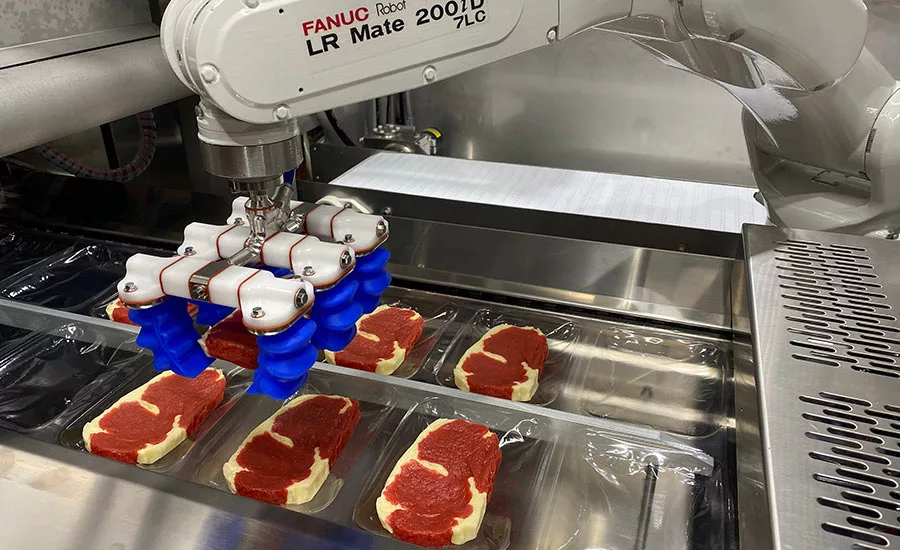
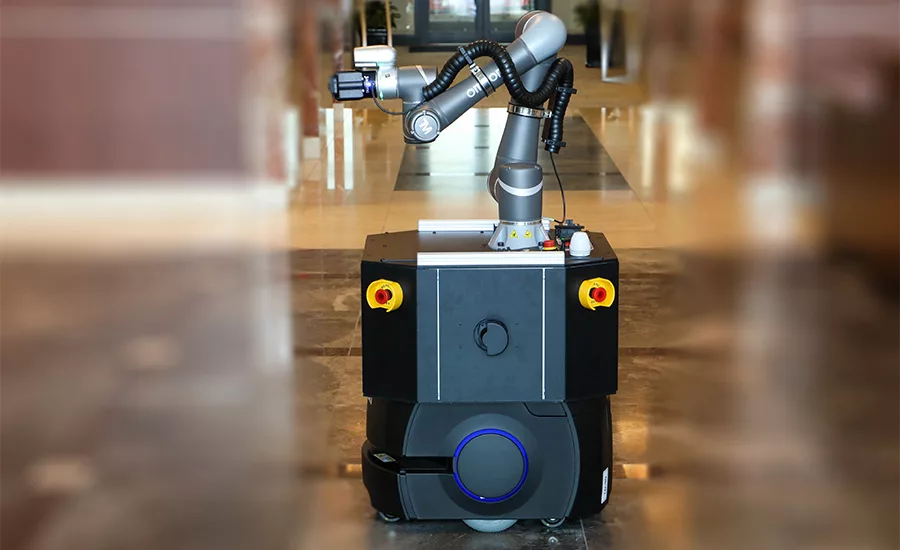


In the first part of this two-part article, we looked at how the use of robotics could help solve some of the problems brought on by COVID-19, especially those of needing to create social distancing and keeping production moving along when people are out sick. We also looked briefly at robot vision, and found that AI and machine learning will play a bigger role in robotics, creating new applications that will be cost-effective in the food and beverage industry. A separate article, "Robotics service and maintenance during the COVID-19 pandemic," describes how robot/automation suppliers are working around the coronavirus pandemic to provide service and maintenance support to their customers.
Vision systems: Robots’ eyes
What can we expect in the future of vision-guided robotics that is practical, reliable and cost-effective? There are tremendous advances being made in vision for measuring product density for portioning, inspecting packaging seal integrity and checking for low-density foreign materials, says Sam Collup, director of sales for Cantrell-Gainco Group. As robotics become more economical and customers’ needs change to reduce reliance on human staffing, robotics for repetitive tasks such as cutting, positioning, and pick-and-place tasks will become more accepted by customers.
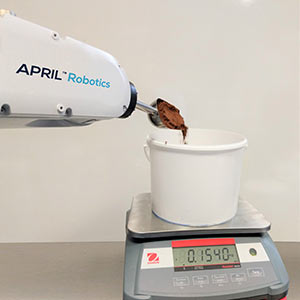 |
Vision can be combined with robotics and other inputs such as a scale to weigh out ingredients shown in this APRIL Robotics cobotics cell. Photo: APRIL Robotics |
With improvements in AI and vision, product variation on the production line is not a challenge for robotics—as it is with humans whose eyes tire easily when performing visual inspections, says Laura Studwell, Omron Automation Americas industry marketing manager, packaging. With continuous feedback, recipes can be changed on-the-fly without disruption or downtime—such as is the case of picking and placing different chicken pieces for a variety pack or different combinations and sizes of packs.
Sometimes full 3D vision isn’t even necessary. Kristian Hulgard, general manager for OnRobot, Americas, explains: "We recently launched OnRobot Eyes, a flexible 2.5D vision system that provides depth information for stacked objects and objects of varying heights. Eyes is a flexible, adaptable vision system that allows users to easily sort, pick and place unstructured items with high reliability using any robot arm. One-picture calibration and part recognition takes just minutes, and programming is intuitive and fast."
Vision can be combined with other sensor inputs such as mass, weight or counters to create filling applications. For example, the Quest Quik Fill™ QF100 series is a family of solutions designed to automate the filling of single/multi-compartment trays, bowls, and clam shell containers, says Naomi Holdvogt, director, marketing, ProMach Robotics & End Of Line, Quest Industrial. Quest uses a combination of 2D/3D vision, specialty scales, and food-safe robotics to tailor an automated solution to each application. These innovative solutions provide robotic automation without the need for investment in costly platens, tooling and dedicated product lines, creating a flexible system that can feed a wide variety of product and packaging styles on a single line. The end result is a very flexible, high-speed, customizable automation system delivering product at a consistent weight and quality.
Quest’s involvement in the produce and dairy industry has provided the experience to be able to design a solution for virtually any product and packaging combination. Most common applications include filling vegetable or fruit trays, clamshell trays and ready-to-eat bowl solutions such as salad kits or snacks.
These solutions provide a less labor-dependent process, and eliminate the human guesswork of how much to fill each compartment. The resulting savings in labor and product waste quickly makes a strong return on investment, says Holdvogt. The company also provides solutions to automate the tote loading process and has a family of pick-and-place solutions for direct food handling.
Sidel’s activity is primarily centered on supporting the production of FMCG (fast moving consumer goods) products with high production volume levels, says Didier Saussereau, packing product manager. “The variability factor is not so much present even if we have been integrating vision systems connected to a pick-and-place packing robot. These vision systems are supposed to secure the product positioning and gripping, ensuring consequently a secured transfer and the right position in the secondary packaging.”
Variability is more about the capability to manage and integrate new packaging formats or collation on regular basis as well as being able to cope with high flexibility needs, adds Saussereau. For this, robotic solutions fit perfectly.
Machine vision systems offer speed, accuracy and repeatability beyond that of humans, making them important tools for inspection, measurement and verification tasks, says Joe Campbell, Universal Robots senior manager of applications development. Recent strides in customizable vision—vision solutions that can easily be swapped out and tailored to individual needs—mean that producers are no longer forced on the generic capabilities of in-built vision systems.
Getting a kinder, gentler grip
While a firm, tight and aggressive grip may be suitable for handling 25-kg bags of sugar or flour, it’s the softer grip that’s been the challenge for robots to handle delicate foods. But how do you get the gentle grip?
Adaptive gripping is one of the most disruptive technology advancements in gripping to date, says Cory Knight Festo automation engineer. In the past, grippers have been known for being strong, repeatable, and precise which, is ideal in applications in which the product and location are uniform, unlike the high product variability in the food industry. This has driven innovation in food automation, specifically in gripping. Even though the food product type and location might be realized, the size, shape, and surface of the food product can still be highly variable. The need for flexibility and adaptability in grippers has caused many companies to innovate in this area. Festo is no exception.
Festo developed the DHAS adaptive gripper years ago, which can turn any standard parallel or angular gripper into a soft gripper. Its fingers were derived from the movement of a fish’s tail fin. The gripper handles corn, avocados, eggplant, apples and oranges, but can work with much heavier objects. The company has also developed a bellows gripper and an adaptive shape gripper. The former is commonly used for bottle gripping, and the latter can grip a wide range of objects in one procedure, making it a good choice for cobotic applications.
OnRobot’s Soft Gripper is specially designed for food handling tasks and is capable of picking, placing and packing even the most delicate foodstuffs, such as strawberries and lettuce, says Hulgard. It also offers seamless integration with a wide range of robot brands including Universal Robots, Kuka, ABB and Yaskawa.
Meanwhile, says, Hulgard, advancements in vacuum grippers enable robots to successfully perform packaging tasks with a delicacy that is beyond the capabilities of traditional grippers, facilitating the adoption of automation in secondary food processing applications.
While delicate products pose problems for robotics, so do meats. Quest, says Holdvogt, has designed versatile robotic picking systems that can load, orientate, stack and group products with custom-engineered proprietary end-of-arm tooling (EOAT), capable of manipulating hard-to-handle products, such as poultry and meats, as well as virtually any other product shape, and product weights under one ounce.
Deboning chicken legs also requires an informed and light touch. Ryuji Kodama, Mayekawa Robot Products, senior general manager explains: “On the TORIDAS chicken whole leg deboning machine, we measure over-all length of the chicken leg and the distance to the knee to identify the difference of the each delicate and variable products and control actuators to process the work. The mechanical device to touch the work has a flexible structure reducing the pressure against the work.”
Need a special gripper? Why not print it? The use of 3D-printed gripping tools (done with agglomerated polymers) is more and more frequent within end-of-line applications, particularly for pick-and-place case packers, says Sidel’s Saussereau. They bring the advantages of being light in weight (easy to manipulate and change for operators); optimized to make energy savings for the robot or even reduce the size of the robot); adapted fully to the product type, shape and resistance; and built-in one piece (including compressed air or Venturi circuits) rather than a complex assembly of small mechanical parts.
Protein cutting/trimming applications remain a challenge
Robotics has been used to cut apart pork carcasses, keeping people away from dangerous jobs—and also doing trimming operations such as deboning pork shoulders and chicken breasts. Water-jet cutting systems are also available to cut out chicken nuggets. Nevertheless, protein applications continue to present various challenges to robotics systems.
So, I had a few questions for our experts on these and similar applications. For example, how cost effective is it to move to using robotics for trimming operations? Is water-jet cutting a good solution? Why aren’t there more protein installations? What are the tradeoffs?
Starting off with the basics, sometimes a 2D solution may work. “When cutting is not extended to 3 dimensions, Cartesian robotics can be more cost-effective than articulated robots,” says Alex Marques, associate product manager for Bishop-Wisecarver. Cutting apparatuses that use Cartesian robots pose a tradeoff between the wear rate of repeated mechanical motion on the linear axes and the wear due to corrosive washdowns. Thus, material selection is important in the balance between mechanical durability and anti-corrosion properties when it comes to linear guides.
While water-jet cutting has been successfully demonstrated for cutting meats that have already been deboned, using the technology for deboning itself is challenging. There have been some installations of water-jet technology for the trimming of deboned meat, says Cantrell-Gainco Group’s Collup. These have not been widely accepted due to the reduced yield associated with this technology versus hand trimming. Many customers prefer hand deboned product over automation due to appearance, bones and yield. The Mayekawa Toridas is the only automated solution on the market that actually does a better job than most all manual operations.
No doubt about it, aesthetics are important. External appearance of the meat after deboning is variable and keeps changing, says Kosuke Matsumoto, senior engineer for Mayekawa Robot Products. The external meat shape and the machine recognition of the muscle tissue to cut is the challenging issue.
In terms of automation, it is difficult to design and build a flexible system to handle meat flowing at random in both sides (top and bottom) on the conveyor for various trimming specifications set by customer’s product needs, adds Matsumoto.
In case of chicken processing, there are many plants processing 10,000 birds/hour or more and there is a need for trimming at high speed after the deboning, says Mayekawa’s Ryuji Kodama. To keep up with the pace, it requires a piece of meat to be trimmed every 5 to 7 seconds. To recognize bone particle, foreign material and surplus skin attached on the meat is technically difficult even with image processing, and therefore, the automation of trimming has not yet been achieved. Bone particles can be detected by X-ray, however cartilage, tendon and skin can not. Cost-effective trimming automation with new detection systems would be the next step for the poultry industry.
While the technology is challenging enough, the environment is not so friendly either. Not only will pieces of meat be flying around making the work cell a mess, cleaning it up takes its toll on equipment. However, improvements in both the design of robots to be operated in harsh environments and the advancements in the capabilities and robustness of vision technologies now make applications in protein processing facilities more of a reality, says FANUC America’s James Cooper, executive director global accounts.
But Cooper is not pessimistic about future implementations for protein processing. “This is a combination of many factors coming together, such as increasing labor costs, less available labor, improved robot and vision capabilities. All of these factors make for more and more applications being deployed in protein processing.”
The cost of protein applications—whether water-jet, saws or knives—will be higher, so processors need to think about the tradeoffs. “The use of robotics in raw meat processing and trimming is a higher investment compared to conventional robotic installations due to the environment and regulations required for the application,” says Festo’s Cory Knight.
The high corrosion resistance requirement and IP ratings place tall demands on the robot components used in the system, adds Knight. High pressure water jet systems are costly and have expensive wear parts and maintenance requirements. Robotic trimming requires dependable machine vision which also has the same corrosion resistance and IP rating requirements. The summation of pricing for robotics, high pressure water-jet systems, and machine vision, which all require corrosion resistant, FDA compliant materials with high IP ratings normally results in a long ROI. Hence, these systems are not as prevalent as one might expect.
While the above might seem like enough downsides, Knight has a few positive considerations. “We’ve seen many methods for calculating ROIs that consider the hidden benefits of automation—which include large quantities of manual labor, e.g. raw meat processing and trimming,” says Knight. Today, it is more difficult to find suitable personnel, especially if less attractive or repetitive tasks are involved. It is for this reason that nowadays not only larger companies, but even smaller ones are faced with the question: how they can meet the daily requirements efficiently, and above all, cost-effectively?
Rising personnel costs due to the intense competitive situation, together with the increasing minimum wages are also having an immense impact, says Knight. An additional, aggravating factor is the stricter hygiene requirements that are prescribed by the EFSA, FDA, and the IFS food standard. The current and future demands placed on the product are also increasing, such as sell-by dates, traceability, and product marketing. Companies that take these additional factors into account when building a ROI have a better picture of the true value of the investment other than simply throughput vs. time.
But, not all proteins are such a problem. Think cheese and lunchmeat—applications that Quest Industrial handles frequently. “Quest provides robotic ultrasonic cutting cells for cheese, produce, and deli meat producers,” says Holdvogt. The ultrasonic cutting process involves a knife vibrating at the speed of sound producing a nearly frictionless surface to which food does not stick nor deform. Quest has been able to master cutting many types of cheese in both wheels and blocks and of all consistencies from hard to soft, and within a small footprint, and with the ability to execute 8 to 120 cuts per minute while changing cut shapes and patterns instantly. This application reduces touches and minimizes issues with viral contamination.
Share your workspace with a cobot!
We talked up the virtues of working with cobots in the first article. Cobots can be used to separate people on a line—provide some social distancing. They’re generally easy to move around, and usually programming is not too difficult—which makes them adaptable to changing applications.
The use of collaborative robots has been increasing with food and beverage customers, says FANUC’s Cooper. They are typically found in low speed applications, such as case palletizing. They also lend themselves well to production environments that are highly dynamic, such as companies who experience a fair amount of seasonal work. Due to the design and safety attributes of a collaborative robot, they are less suitable for high volume food and beverage producers, due to both speed and payload requirements found in these industries.
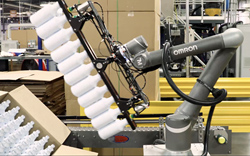 |
The applications for collaborative robotics are rapidly expanding, and many of these involve helping to deliver material to production processes or packaging the final product. Photo: Omron Automation Americas |
However, the applications for collaborative robots are rapidly expanding, says Omron’s Studwell. “Omron is helping customers integrate them upstream in various stages of primary processing, handling applications such as weighing raw material inputs and picking strawberries off a plant to delicately icing cupcakes. We’re also helping integrate cobots downstream from packing plastic bottles to stacking egg cartons. Perhaps one of the most unique applications Omron has worked on is selecting bell peppers for placement into a traffic light pattern.”
“I was indirectly involved in a project in which the company was using a cobot to pack trays with a variety of baked goods based on the specific end customer demand,” says Festo’s Knight. The end effector design was quite challenging since the gripper had to be able to pick every product type the bakery produced. A Universal Robots cobot was used to eliminate the need for safety fencing or scanners since operators were in constant proximity. The simple programming of the cobot made it an attractive option for the bakery, which didn’t have experienced robot programmers onsite, nor did they have any robots previously installed.
If you think baked goods are delicate, how about handling herbs (the actual plants)? OnRobot’s Hulgard describes a delicate application. Denmark’s largest producer of herbs and mini plants, Rosborg Food Holding, chose an OnRobot gripper as part of a cobot deployment that involved handling delicate plants. The cobot enabled Rosborg to accommodate growing demand without having to hire additional labor, which was no mean feat considering the fact that Rosborg produces, packs and sells an estimated 28 million herb plants and 12 million mini flowers annually.
Two arms are better than one! Kawasaki offers a two arm SCARA type collaborative robot called duAro, says Samir Patel, senior director—robotics engineering. It has been successfully used in the food prep facilities. Thousands of lunch kits with freshly prepared food items like chicken nuggets, vegetables, rice balls, condiments, etc. are required every day before noon for distribution to outlets such as 7-Eleven. This is one interesting application where the duAro repeatedly builds quality lunch kits while working side-by-side with operators.
Let a cobot do its job while human team members work right around it. Global food and beverage player Nestlé installed Sidel’s CoboAccess™_Pal (S version with 8 kg payload) at their site in Orbe (Switzerland). (See FE, “Palletizing cobots handle tea, ease workload“ for the full story!) By automating the palletizing of their Special.T capsules, Nestlé gained higher pallet quality, while offering increased ease-of-operations for its workers. The latter benefit was ensured by the solution’s automation platform: based on the combination of PC and PLC, it ensures better-controlled trajectories for improved cobot picking and placing.
Universal Robots has more than 44,000 cobots deployed worldwide, according to Campbell. These robots are good candidates for labeling, packaging and palletizing. Campbell describes one application: Atria Scandinavia, one of northern Europe’s leading manufacturers of vegetarian and gourmet products for convenience markets and retail chains, deployed two UR5s and one UR10 cobot at the end of three production lines to take care of labeling, packaging and palletizing tasks. This helped Atria minimize downtime and reduce carton waste by 25%.
“R2-D2”—going mobile
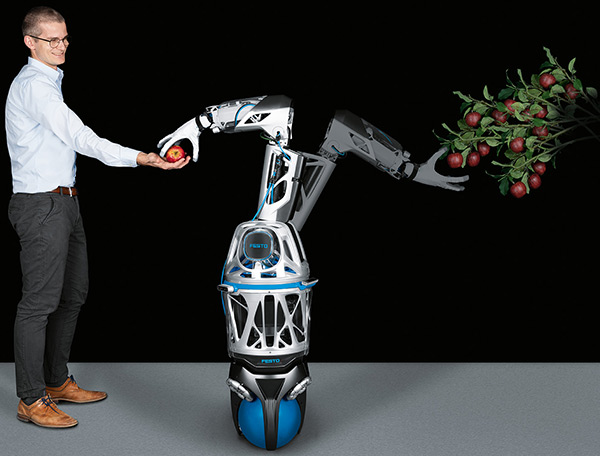 |
Cobots on the move. Festo’s behind the design on this Bionic Mobile Assistant, aka an autonomous mobile robot, which can understand and move safely through an environment without any human assistance. Photo: Festo |
Give a cobot the means to move intelligently, and you’ve got an autonomous mobile robot (AMR) as Festo’s Knight calls it or a MOMA (Mobile Manipulator) as Omron Automation terms it. Festo’s Knight sees this new-found mobility with a keen sense of its surroundings a big deal.
“A massive disruption in the market is happening in the field of AMRs,” says Knight. The past few decades have brought monumental changes to the world of order fulfillment and material handling. A shrinking pool of qualified workers and demand for shorter delivery times has caused a ripple in the way companies are looking at material handling. Though conventional warehouse robots such as AGVs have been around for years, many companies are looking for new technology, which offers higher flexibility and ease of installation.
An AMR is any robot that can understand and safely move through its environment without being overseen directly by an operator or on a fixed pre-determined path, says Knight. AMRs have a plurality of scanners which enable them to understand and interpret their environment, which helps them to perform their task in the most efficient manner and path possible while navigating around fixed and variable obstructions. In a warehouse and/or distribution center environment, these sophisticated technologies are integrated with the warehouse’s control system, which allows AMRs increased flexibility to create their own routes between locations.
Companies are adopting this new technology at a rapid pace and are looking for top module automation. Since the AMR is a tool to travel from point A to point B, work must be done at each stopping location to pick, check, or pack an order. Festo’s large offering of low power and electric automation components has caused several integrators to inquire about using these components in custom top module automation.
Omron released the Mobile Manipulator (MOMA) which debuted at PackExpo Las Vegas 2019, says Studwell. MOMA is a combination of the LD mobile robot with a TM collaborative robot mounted on top. The MOMA can handle many applications such as picking parts from bins in a warehouse and then delivering the parts to individual workstations on a defined schedule. Since it can store many different programs, it can be easily substituted on different production lines throughout a shift to help with a variety of different tasks.
Omron is working with key integration partners to develop UV sterilization mobile robots, which disinfect surfaces all over food and beverage plants and grocery stores including ancillary high-traffic places such as bathrooms, door knobs and other areas that can carry germs with can be brought back to the production line. We’re also working with another integration partner to develop a mobile robot scrubber, which can scrub floors using harsh detergents. This can be done throughout the day without disrupting production using vision, sensors and safety to uniquely move around obstacles.
Picking up on cleaning applications, Universal Robots’ Campbell described an ongoing project. In mid-April of 2020, researchers from Nanyang Technological University unveiled a mobile disinfection robot powered by a UR5 cobot fitted with an electrostatic spray nozzle. And when COVID-19 restrictions saw traffic at Portland’s In J Coffee Shop plummet by 50%, the shop’s owners developed a contact-free, cobot-powered system for preparing specialty coffee—latte art included.
Festo-US developed a turnkey lifting top module for an application that used MIR AMRs. Companies might not be aware that Festo can offer these types of solutions via its customer solution department.
“We see tremendous opportunity for low power, light weight, Cartesian robots being used for top module automation in AMR applications. Just imagine all the benefits of Cartesian robotics with the added gain of safe, unguided mobility, says Knight.
Online Resources:
OSHA: “Industrial Robots and Robot System Safety”
National Institutes of Health (Section on cobots): “Working Safely with Robot Workers: Recommendations for the New Workplace”
NSF: “National Robotics Initiative 2.0: Ubiquitous Collaborative Robots (NRI-2.0)”
IEEE/NIST: “Characterizing Task-Based Human-Robot Collaboration Safety in Manufacturing”
For more information:
ABB Robotics, https://new.abb.com/products/robotics
APRIL Robotics, https://www.oalgroup.com/april-robotics
Bishop-Wisecarver, www.bwc.com
Cantrell-Gainco Group Inc., https://cantrellgainco.com/
FANUC America, www.fanucamerica.com
Festo, https://www.festo.com/us/en/
Kawasaki Robtoics, USA, https://robotics.kawasaki.com/
Mayekawa Robot Products, https://mayekawa.com/americas
Omron Automation Americas, https://automation.omron.com
OnRobot, Americas, www.onrobot.com
Quest Industrial/ProMach product brand, www.questindustrial.com
Sidel, www.sidel.com
Universal Robots USA, www.universal-robots.com
Looking for a reprint of this article?
From high-res PDFs to custom plaques, order your copy today!







